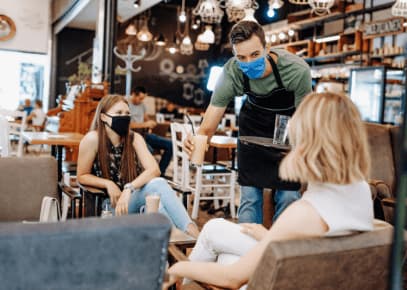Key Takeaways
Enough has been said about the unrivaled impact of coronavirus on the restaurant industry. So I’m not going to talk more about it. Because I really think it’s time to look beyond what’s happened and focus on solutions that would help us all thrive in the new world. Of course, there would be unprecedented challenges, which need to be addressed, but the beauty of today’s digital world is that we were already hands-on with technologies that helped us weather the storm gracefully. And we are grateful for them, aren’t we?
Perhaps the new world has given rise to new business models, or let’s say, has accelerated people’s adoption rate for technologies and innovative concepts and one of those is the most popular, yet relatively newer restaurant concept trend, Pop-up kitchens - of course, now they are more advanced delivering better service at all touchpoints.
But if you’re new to this concept or apparently, looking to invest in one, this guide will help you make an informed decision.

What are Pop-up Kitchens or Restaurants?
A pop-up restaurant is a relatively new trend seeing an upward trajectory in the restaurant industry, especially now that most aspiring entrepreneurs are wary of opening a new restaurant before investing in a full-fledged restaurant. Pop-up kitchens are more like a temporary restaurant that allows chefs to showcase culinary talent, test new audiences, as well as experiment with edgier cuisine. A lot of chefs also use this concert to raise funds for social causes or draw new investors for their new restaurant business.
But of course, if we talk about the restrictions imposed due to coronavirus outbreak, the concept of pop-up kitchens has taken a 180-degree turn. Chefs are still opening up these short-term restaurants, but instead of serving customers on the location, they are offering off-premises dining such as takeaway, curbside pick up, and doorstep delivery. For example, Manhattan-based food hall Sous Vide Kitchen opened in early 2018 is typically limited to delivery orders.
Benefits of Pop-up Kitchens
Experiment with cuisines: Planning to launch a new concept restaurant? Japanese cuisine in a rural neighborhood or maybe Singaporean Palate in the land of Hollywood Lovers - either way, a pop-up kitchen would be the best bet to start your culinary journey.
Create a buzz - even before you have become a legit dine-in place. All you need is an effective social media strategy and leverage geofencing tools to capture the attention of people in your location. When done right, digital marketing can help you create a recognizable brand sooner than you’d expect.
Sway customers: Everyone knows that pop-up kitchens are not forever. There is always a sense of urgency that customers feel to try any new pop-ups in the neighborhood. Use this to your advantage to increase sales volume.
Premium price: The novelty nature of these types of restaurants appeals to all generations, which means that they are willing to pay a premium price on foods and concepts they’ve never encountered before.
How to set up a pop-up kitchen during the pandemic
Setting up a pop-up kitchen is really easy and doesn’t require much of an investment in terms of equipment and staff. You can get it all done with basic necessities and a couple of kitchen staff to speed up the preparation process. However, setting up a pop-up kitchen during pandemic times may require you to hire delivery drivers to fulfill online orders, or perhaps, you can tie up with a third-party delivery service like Postmates that work on a flat-fee model.
So what all you need to set up a pop-up kitchen successfully?
Location: First things first, you must find a location that you think would have enough takers for your menu offerings. On top of that, choose a location that doesn’t come under the high-risk COVID zone so you don’t have to worry about wrapping things sooner than you had planned.
Business License: Check with your local authorities to see what business licenses and insurance you need to run a pop-up restaurant. If you plan to serve or deliver alcohol, you’ll need an alcohol license also.
Create a small menu: Because pop-up kitchens are typically short on storage, you may not be able to carry a lot of supplies at a time. Limiting the menu to not more than 20 items should work for you. But if you really want to entice customers and give them the reason to keep coming back to you, change your menu every few nights and have a unique chef’s special every day. More tips on creating a small menu here.
Online ordering: Now with social distancing, you really can’t expect people to stop by at your pop-up store to enjoy a meal or two and you can’t even crowd up the place with long queues. But businesses must generate some revenue and this is only possible if you have an efficient online ordering system in place that your customers can use to place orders online. See how online ordering can help your restaurant grow profitability.
Contactless solutions: COVID-era and contactless solutions go hand in hand. You really cannot miss implementing contactless technology for restaurants if you want your customers to trust your business for maintaining an optimal level of hygiene and safety. Contactless Ordering or QR Menu Ordering enables your customers to place orders by scanning the unique QR code on their mobile phones. They can then browse the menu on their phone, place an order as well as make the payment, completely eliminating unnecessary human contact. Know more about Restolabs Contactless Solutions Here.
Do you think you have what it takes to open a successful pop-up restaurant?
Over the last few months, the Restolabs team has helped hundreds of chefs set up virtual pop-up kitchens. More than that, we couldn’t have anticipated that these pop-up restaurants would immediately have a flock of customers willing to order from them online. Luckily, these test the concept restaurants give their customers the flexibility of ordering so they keep coming back for more, especially with the pandemic fatigue setting in.
It’s not necessary to become 100% digitized in order to reap the benefits of a pop-up restaurant. You can set up dining sections in a way that adheres to all standard safety protocols set by the state government. In fact, in our view, the best approach is to go hybrid. The hybrid business model allows your business to test the waters before getting fully committed to a physical presence. Since we are living in unprecedented times, there is a high chance that virtually becomes mainstream, in that case, you’ll find yourself in a strategically advantageous position.
Make sure to partner with a restaurant online ordering system that’ll accommodate all your needs as you grow into a full-fledged establishment.
If you want to learn more about how Restolabs can make it all happen for your restaurant brand – Contact us to schedule a free demo of our powerful platform today.
Frequently Asked Questions


.gif)
.jpeg)


.png)




